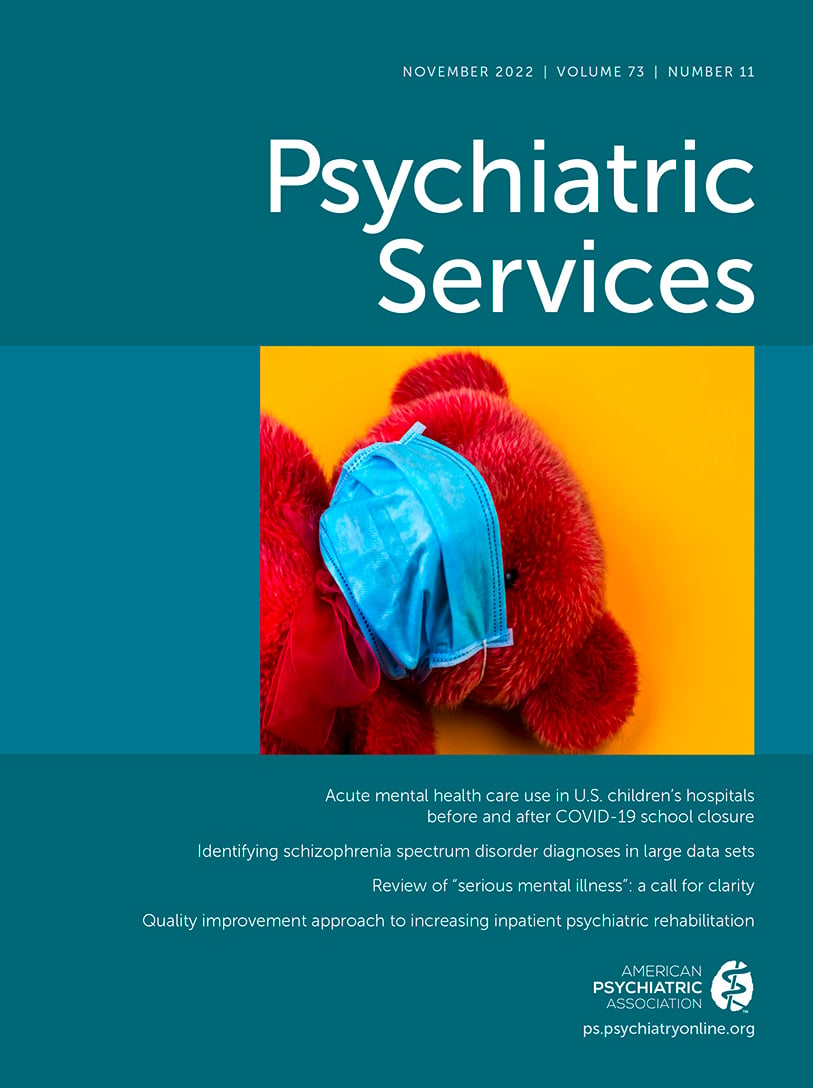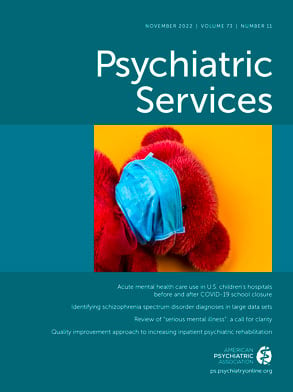Despite having rates of psychiatric disorder similar to those of their non-Hispanic White counterparts, Black and Latinx youths receive a lower quantity and lower quality of mental health services and have critically higher rates of unmet need (
1). Research has shown persistent disparities in diagnosis, service access, and the quantity and quality of treatment, all of which lead Black and Latinx youths to have worse outcomes in many domains beyond mental health (
1).
The broader health services literature points to health care providers’ bias as a major contributor to persistent disparities (
2). Clinician bias includes prejudice (both positive and negative evaluations) and stereotyping (traits associated with a given social group). Prejudice and stereotyping can manifest as implicit biases that are relatively less conscious or controllable than explicit or overt biases (
2). Implicit bias has been shown to negatively affect clinical decision making and patient-provider relationships, both of which can lead to downstream disparate outcomes for minoritized populations compared with non-Hispanic Whites (
2). Because implicit biases may influence behavior outside of one’s awareness or conscious control, their impacts may be present in almost any interaction between health care providers and patients belonging to minoritized groups (
3). Thus, understanding clinicians’ knowledge of the specific stereotypes of minoritized patient groups can inform the development of interventions designed to reduce discrimination.
Although there is an established literature on health care providers’ implicit racial bias (
4), only a few of those studies included mental health professionals, a group that has been shown to be more empathic (
5) and, by extension, possibly less biased than other health care professionals (empathy has been shown to reduce bias [
6]). However, bias among mental health clinicians may have a greater influence on producing disparate outcomes, compared with bias among other health care providers, given the field’s limited adoption of treatment algorithms or standardized guidelines, which could mitigate the impact of clinician bias (
7). The literature also primarily focuses on bias toward Black adult patients, with only a few studies examining bias toward youths or other minoritized populations (
4). Previous research with non–health care populations (e.g., teachers, undergraduates) has found that adults have implicit racial bias toward youths as young as preschool age (
8).
School is the most common setting for youth mental health service delivery and one that has been shown to ameliorate some service disparities (e.g., access), while others persist (e.g., treatment engagement) (
9). No studies have examined school-based mental health clinicians’ racial bias toward youths. Improving understanding of bias among school-based clinicians is an important step in addressing pediatric mental health service disparity in a setting where youths are most likely to access mental health care. This column describes two novel studies of school-based clinicians’ knowledge of stereotypes and implicit bias toward Black and Latinx youths.
Study 1
As part of a series of studies contributing to the development of an online implicit-bias intervention for school-based mental health clinicians, this study aimed to identify stereotypes of Black and Latinx youths known to school clinicians.
Methods
A geographically diverse U.S. sample of school-based clinicians (N=42) was recruited via relevant professional Listservs. Demographically representative of school-based clinicians nationally, the sample was predominantly White (N=34, 81%) and female (N=40, 95%), with 10% (N=4) identifying as Black and 7% (N=3) as Latinx. Following the approach of Bean and colleagues (
3), we asked participants to complete a brief online survey that prompted them to “think about conversations [they’ve] overheard or had with [their] colleagues” and identify “behaviors or characteristics [they] think school mental health professionals most commonly associate with” Black youths and, separately, with Latinx youths. For each minoritized group, participants were first asked to generate free responses and then to select the top three from a list of 14 characteristics, seven of which were previously documented in the literature (i.e., aggressive, angry, delinquent, gang-involved, low IQ, poor academics, and unmotivated) and six of which were positive or neutral attributes included for balance (i.e., conscientious, easygoing, hardworking, high achieving, natural leader, passive). The same list of characteristics was used for Black and for Latinx youths.
Following established methodology for thematic coding of qualitative data, participants’ free responses were systematically reviewed and coded by three independent coders blinded to the identified minoritized group. This process (delineated in the
online supplement) reduced each free response to nominal data that indicated whether high-frequency stereotypes (i.e., aggression and anger, academic failure, delinquency, lack of motivation) were identified by each participant. Cross-category coding, following the methods of Bean and colleagues (
3), was then completed, such that if a participant indicated a stereotype either in the free response or in the top three multiple-choice selections, the response was categorized as a stereotype for the relevant minoritized group.
Results
Eighty-one percent (N=34) of participants identified academic failure as the characteristic most frequently associated with Black and with Latinx youths. Whereas 76% (N=32) identified anger/aggression as a stereotype for Black youths, only 29% (N=12) identified this characteristic as a stereotype for Latinx youths (χ
2=18.38, df=42, N=1, p<0.01). The second- and third-most frequently identified stereotypes for Latinx youths were being unmotivated (N=26, 62%) and delinquency/rule breaking (N=20, 48%). These two stereotypes were fourth- and third-most frequently identified for Black youths (N=19, 45%; N=23, 55%, respectively) at rates not significantly different from those of Latinx youths. (See the
online supplement for a graph and table of chi-square analysis results.)
Study 2
Based on the findings of study 1, four distinct Implicit Association Tests (IATs) were developed to assess school-based mental health clinicians’ implicit prejudice and stereotyping of Black and Latinx youths relative to non-Hispanic White youths. The IAT, the most well-established measure of implicit biases (
10), is a computerized categorization task that measures the relative strengths of associations by examining the speed with which people assign images and words to categories. For example, people who have stronger pro-White or anti-Black biases would be faster at pairing White people with good things (e.g., words of positive attributes and connotations) and Black people with bad things (e.g., words of negative attributes and connotations) than the reverse. This difference in reaction times can be computed as a D score (i.e., IAT difference scores); in this example, positive scores indicate a pro-White or anti-Black bias, negative scores indicate a pro-Black or anti-White bias, and scores of 0 or near 0 indicate no bias.
Methods
A new sample of school-based mental health clinicians (N=58) was recruited for study 2 by using the same procedures as study 1. The sample was again predominantly White (N=43, 74%) and female (N=52, 90%), with 19% (N=11) identifying as Black and 9% (N=5) identifying as Latinx. Participants completed all study procedures online via a secure data collection platform (Qualtrics), including the four IATs; a questionnaire collecting demographic characteristics; and the Bias Awareness Scale, a four-item questionnaire that measures awareness of and concern for one’s own implicit bias (
11). Participants were asked about their awareness of bias toward Black and Latinx youths separately, yielding two distinct bias awareness scores.
The original Black-White IAT and the more recently developed Latinx IATs all use sets of adult faces. To the best of our knowledge, no previously published IATs have used faces of Black or Latinx youths, representing the full developmental range of school-age youths (i.e., kindergarten through 12th grade). Thus, we developed two IATs to assess implicit prejudice (i.e., biases toward Black vs. White youths and toward Latinx vs. White youths) and two IATs to assess implicit stereotyping (i.e., assessing defiance/obedience as being associated with Black vs. White youths and academic failure/academic success as being associated with Latinx vs. White youths) on the basis of the two most frequently identified stereotypes found in study 1. This process was completed in accordance with established best practices for IAT development (see the
online supplement for more details, including a complete reference list relevant to the methodology and the list of photo stimuli and attributes used).
Results
All four IATs performed as expected, with adequate internal consistency (α=0.71–0.91) and low rates of dropped trials (5%–6%) and dropped participants (one per IAT) due to invalid responding (e.g., too slow, too fast, or making too many errors). All four IATs generated average D scores between 0.30 and 0.42, indicative of implicit prejudice or stereotypes favoring White over Black and Latinx youths. These results (Cohen’s d=0.81) were similar to those previously reported among health care providers (
4) and among the general population toward minoritized racial-ethnic groups (
12). All four IATs were positively correlated with each other (suggesting that they captured clinician bias in similar ways) and negatively correlated with participants’ self-reported awareness of their own implicit bias, as expected (i.e., those who demonstrated greater implicit bias reported less personal awareness and concern for implicit bias). (See the
online supplement for psychometrics and correlation tables.)
Discussion
These two studies on school mental health clinicians’ knowledge of stereotype and implicit bias contribute foundational knowledge toward developing interventions to address implicit racial bias among mental health professionals working in schools—the setting where youths are most likely to access mental health services (
9).
Knowledge of stereotypes is a critical antecedent to biased care because stereotype knowledge can cause biased behavior even when clinicians do not endorse those stereotypes. Findings from study 1 suggest that most school mental health clinicians are aware of stereotypes about Black and Latinx youths. Several stereotypes, including academic failure, delinquency/rule breaking, and being unmotivated, were attributed roughly equally to both Black and Latinx youths, but anger/aggression was clearly more often identified for Black than for Latinx youths. These stereotypes shed light on putative mechanisms through which clinician bias can lead to care disparities. For example, implicit associations of Black youths with anger and aggression may lead to overidentification of oppositional defiant and conduct disorders and underidentification of other diagnostic explanations of noncompliant behavior, such as attention-deficit hyperactivity disorder. Similarly, if Latinx and Black youths’ disengagement from school is stereotypically attributed to academic failure, lack of motivation, or delinquency, other potential contributors such as learning disabilities, depression, or anxiety could go underidentified and unsupported.
The results of study 2 not only substantiate the presence of implicit bias among mental health professionals, similar to that of other health care providers, but also demonstrate that those biases apply to youths, which is consistent with previous findings regarding other youth-oriented professionals (
8). Study 2 also provided four new IATs to support the study of implicit racial-ethnic biases toward youths (available from corresponding author on request). The IATs comparing Latinx with non-Hispanic White individuals were especially novel, given that previous studies of implicit racial-ethnic bias focused predominantly on Black-White comparisons. Given the possible negative downstream impacts of implicit bias on minoritized youths, the availability of these research tools allows the field to not only better detect implicit bias but to more effectively measure the impact of interventions to reduce implicit bias.
The small samples in both studies limit the generalizability of findings, such that replication is needed before firm conclusions can be drawn. Commonly cited limitations of the IAT are also relevant, particularly those related to the IAT being a measure of relative bias (e.g., pro-White/anti-Black) as opposed to assessing bias about a single construct. In other words, although we know that study 2 found that school-based clinicians held stronger implicit associations of Black and Latinx youths with negativity, defiance, and academic failure relative to White youths, we cannot make inferences about the strength of these associations in absolute terms.
Conclusions
Together, these studies represent a first examination of school mental health clinicians’ knowledge of stereotypes and implicit racial bias involving youths. They provide important foundational knowledge and research tools (new IATs) to better understand how clinician bias contributes to biased care and disparate outcomes in youth mental health.

